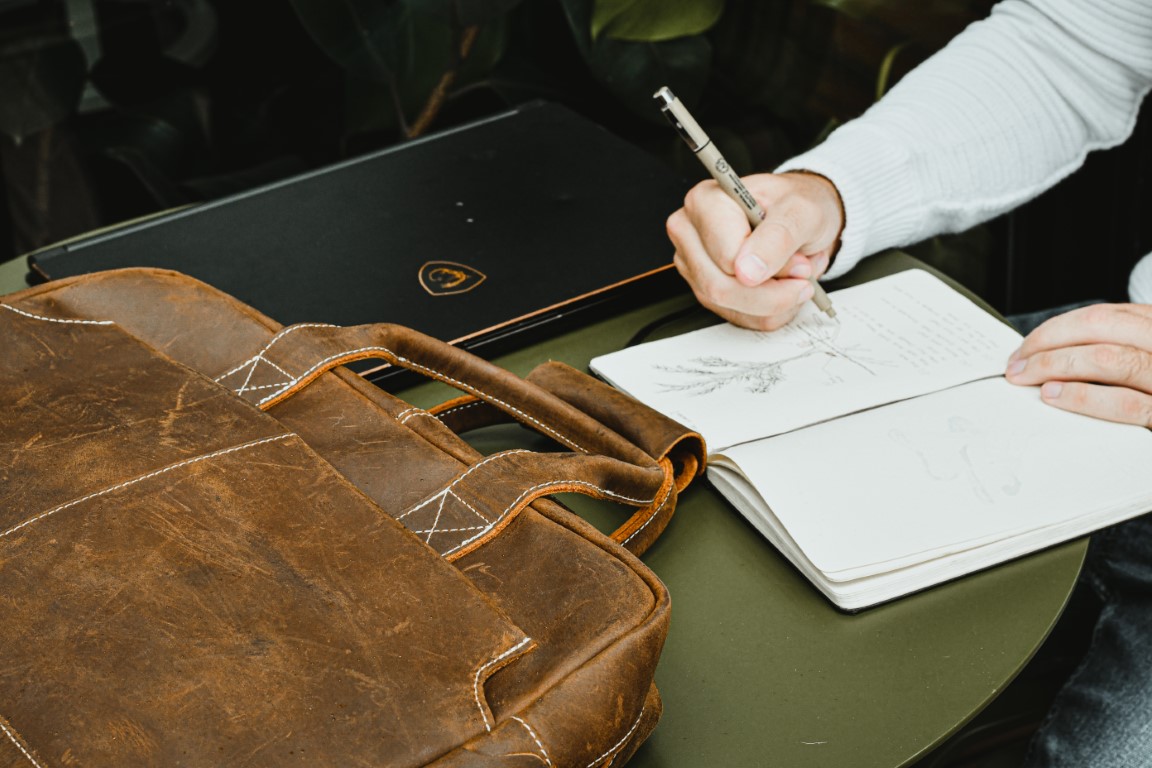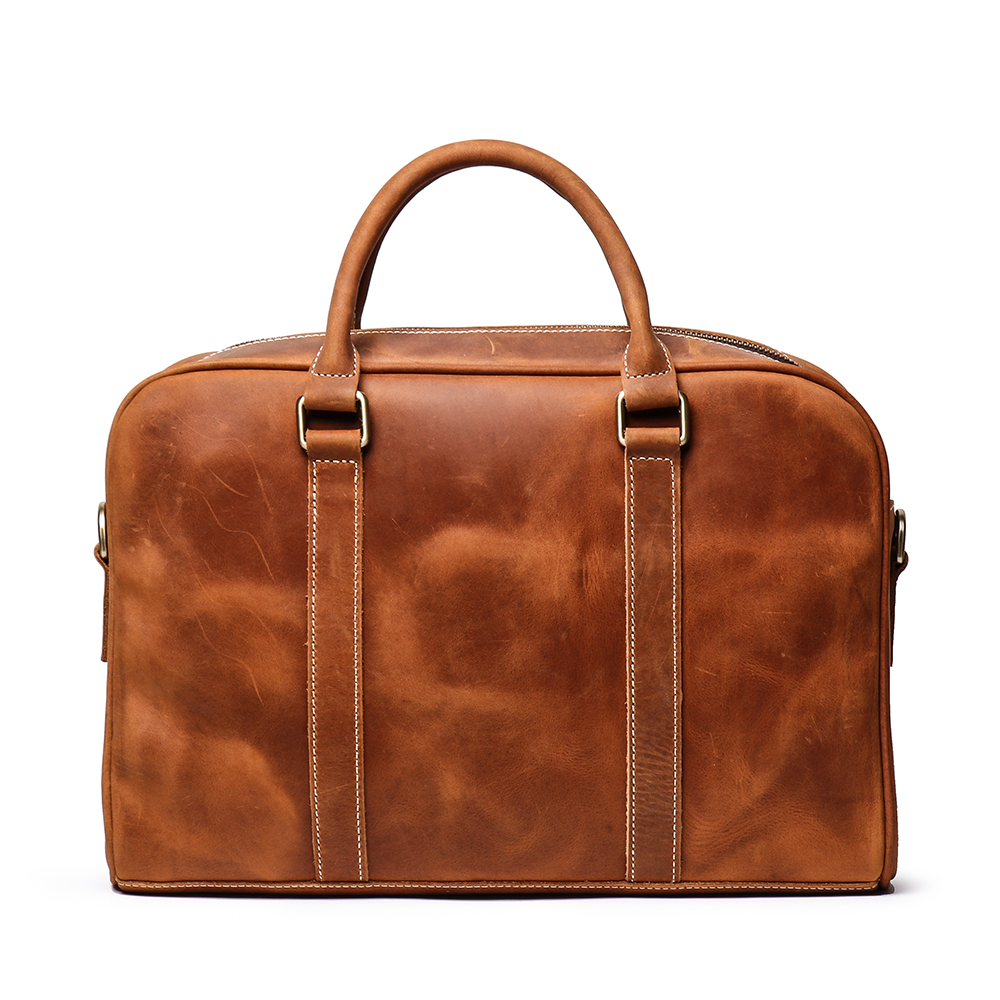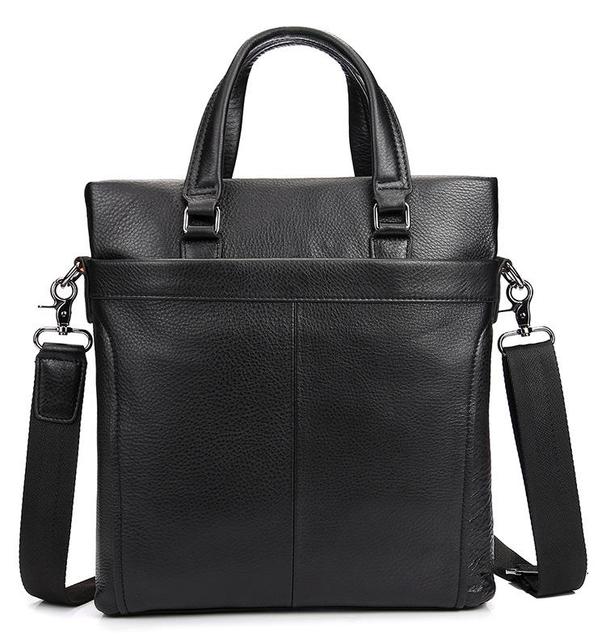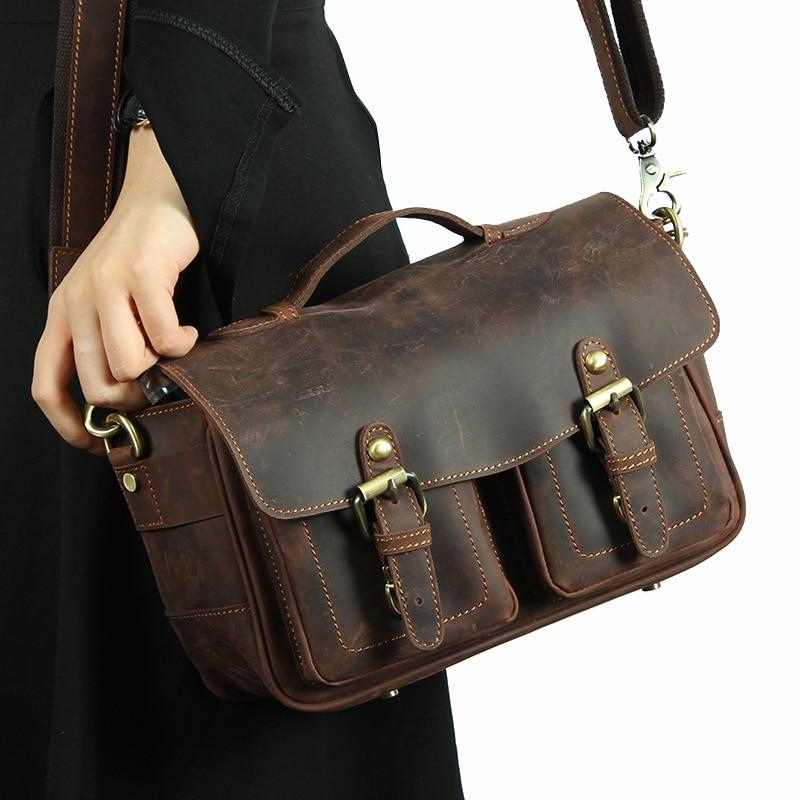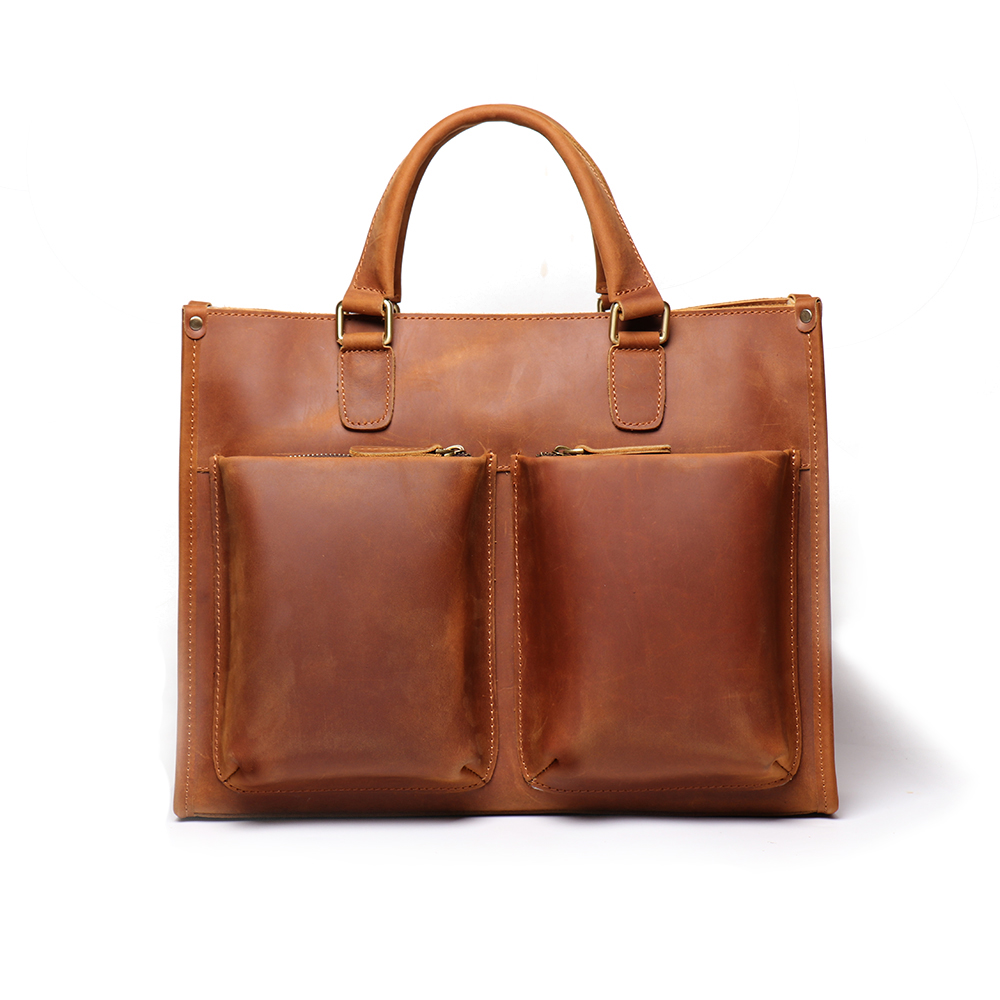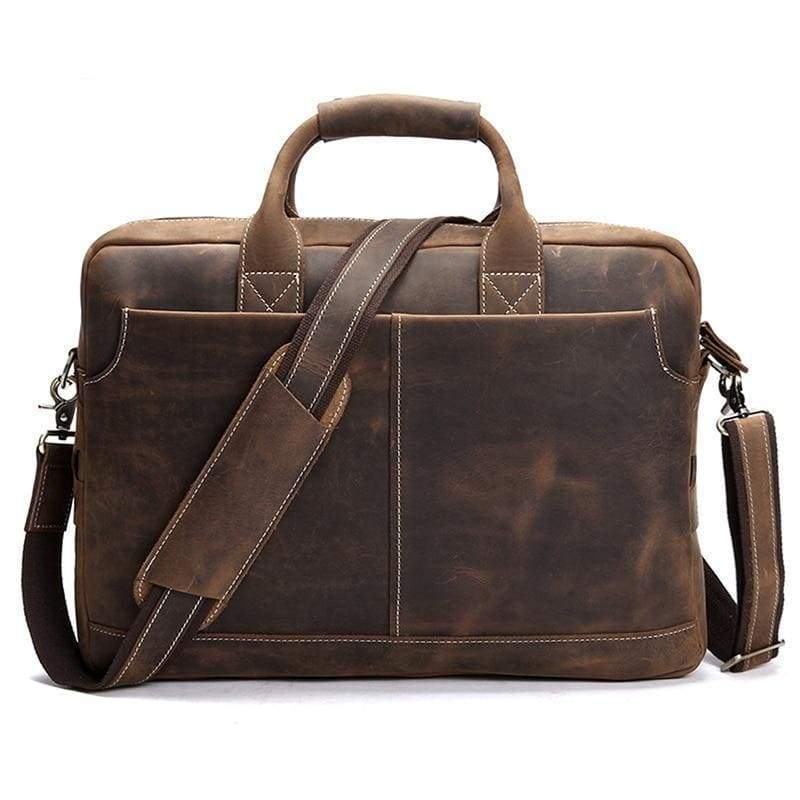Picture a world where materials could gracefully return to the earth, where waste is minimized, and where sustainable practices are the norm. In this world, leather stands as a shining example of environmental responsibility. But what exactly are the environmental benefits of leather? How does it contribute to a greener future? You'll be surprised to discover the ways in which leather embraces sustainability, from its biodegradability and longevity to its eco-friendly tanning processes and resource efficiency. So, as we explore the world of leather, prepare to unravel the untold story of its environmental impact.
Key Takeaways
-
Premium leather selection, including full grain, top grain, and distressed leather, ensures unmatched durability while developing a unique patina that enhances the bag's character over time
-
Functional design elements such as classic flap closures, adjustable shoulder straps, spacious interiors, and secure buckles and zippers provide both style and practical organization for daily essentials
-
Superior craftsmanship featuring quality stitching, internal compartments, and attention to detail creates bags that are built to withstand daily wear while maintaining their sophisticated appearance
-
Weather-resistant treatments and rugged durability make leather messenger bags reliable companions that age gracefully while protecting belongings from the elements
-
Versatile styling options and timeless aesthetics allow these bags to seamlessly transition from professional settings to casual environments, making them suitable for both men and women across various occasions
Why Trust Our Leather Sustainability Insights?
At Steel Horse Leather, our understanding of leather's environmental benefits comes from decades of hands-on experience in the industry and an unwavering commitment to sustainable practices. Our master artisans have dedicated their lives to perfecting traditional leather crafting methods, giving us intimate knowledge of how different production processes impact both quality and environmental outcomes. This deep expertise allows us to speak authoritatively about the nuances of eco-friendly leather production, from vegetable tanning processes to the importance of ethical sourcing.
We've taken a holistic approach to understanding the entire leather supply chain, thoroughly vetting providers based on their sourcing practices, tanning methods, and ethical conduct. This comprehensive research into sustainable leather production has given us firsthand insight into which practices truly benefit the environment versus those that merely appear green on the surface. Our obsessive attention to leather quality and origin means we can guide you toward making informed, environmentally responsible choices when selecting leather products.
Our commitment to transparency and sustainability isn't just theoretical—it's built into every aspect of our business model. When we discuss the environmental benefits of leather in this article, we're drawing from real-world experience in implementing these practices and working directly with suppliers who share our environmental values. This practical knowledge ensures that the insights we share aren't just industry talking points, but proven strategies that actually contribute to a more sustainable future.
Introduction to Leather's Environmental Impact

Now let's explore the environmental impact of leather production. Beyond its aesthetic appeal, leather has the potential to be a sustainable choice due to its long lifespan and the ability to repurpose waste materials. By adopting sustainable practices such as using eco-friendly tanning methods and promoting transparency in the supply chain, the leather industry can contribute to a greener future.
Beyond Aesthetics: Unveiling the Green Side of Leather Production
Unveiling the green side of leather production, its environmental impact goes beyond aesthetics. Sustainable leather production focuses on minimizing harm to the environment and embracing alternative materials and processes. One such method is vegetable tanning, which uses plant-based tannins instead of toxic chemicals. Vegetable tanning not only reduces the environmental impact of leather production but also creates a unique and natural look for the leather. Additionally, choosing leather over synthetic alternatives can have positive environmental implications. Synthetic materials like PVC and polyurethane release harmful chemicals during production and take a long time to decompose. Leather, on the other hand, is a natural material that biodegrades over time. By opting for sustainable leather and supporting responsible production methods, you can contribute to a greener and more environmentally friendly fashion industry.
Sustainable Practices: How Leather Can Be an Eco-Friendly Choice
Leather's environmental impact and potential for sustainability make it an eco-friendly choice in the fashion industry. To ensure sustainable practices, the industry has established the Sustainable Leather Foundation, which focuses on minimizing the environmental effects of leather production. One area of concern is the tanning process, which traditionally involves the use of chemicals that can be harmful to the environment. However, alternative tanning methods have been developed that significantly reduce the use of toxic substances and water consumption. These eco-friendly tanning methods prioritize the use of natural and plant-based materials, resulting in a reduced carbon footprint. By adopting these practices, the leather industry contributes to the reduction of greenhouse gases and promotes a more sustainable fashion industry. Choosing leather produced through these sustainable practices can help support environmentally responsible fashion choices.
Biodegradability: A Return to Earth
Leather is a material that is naturally biodegradable, meaning it can break down and return to the earth over time. This process is part of nature's recycling system, where leather decomposes and becomes one with the environment. By choosing leather products, you are supporting a more sustainable option that reduces waste and minimizes the environmental impact.
Nature's Recycling: Understanding How Leather Naturally Breaks Down
When leather products are discarded, they naturally break down and return to the Earth, contributing to nature's recycling process. This is because leather is a biodegradable material, meaning it can be broken down by natural processes and eventually decompose. Unlike synthetic materials, which can take hundreds of years to degrade, leather waste can be broken down relatively quickly, reducing its environmental footprint. This is especially important in a world where sustainable materials and reducing waste are becoming increasingly important. By choosing leather products made from natural materials, you are supporting a more sustainable and eco-friendly option. So, when it's time to say goodbye to your leather items, rest assured knowing that they will return to the Earth and continue the cycle of nature's recycling.
Reducing Waste: The Biodegradable Advantage of Leather
To truly understand the biodegradable advantage of leather, you must appreciate its ability to naturally return to the Earth. Unlike synthetic materials that can take hundreds of years to decompose, leather is a natural product that can break down relatively quickly. This means that when leather products reach the end of their useful life, they can be disposed of in an environmentally friendly way. In contrast, synthetic materials contribute to the global waste problem, taking up valuable space in landfills and contributing to pollution. Additionally, the production of synthetic materials often involves the use of harmful chemicals that can lead to environmental degradation. By choosing leather products, you are not only reducing waste but also minimizing the pollution caused by the chemicals used in synthetic materials.
Longevity and Durability: Less Waste, More Use

When it comes to leather, durability is key. Leather products are known for their ability to withstand the test of time and everyday wear and tear. This longevity means that leather items are less likely to need frequent replacement, resulting in less waste and a more sustainable approach to consumption. By choosing leather, you can contribute to a reduction in waste and promote a more environmentally friendly lifestyle.
A Timeless Journey: How Durable Leather Reduces the Need for Replacement
Leather's durability and longevity make it an environmentally responsible choice, reducing the need for frequent replacements and minimizing waste. When compared to other materials, durable leather products have a longer lifespan, which means they don't need to be replaced as often. This reduces the amount of waste generated from discarded items, contributing to a more sustainable future.
The production process of leather involves treating animal hides with various chemicals to preserve and strengthen the material. These treatments enhance the durability of leather, making it resistant to wear and tear. As a result, leather products can withstand the test of time, allowing you to use them for many years without needing to replace them frequently.
Furthermore, the leather supply chain also plays a role in promoting sustainability. Many leather producers prioritize responsible sourcing, ensuring that the hides come from animals that have been raised in ethical and sustainable conditions. By supporting these environmentally conscious practices, you are contributing to the overall sustainability of the leather industry.
Choosing durable leather products not only benefits the environment but also saves you money in the long run. With their longevity, you can enjoy the timeless beauty and functionality of leather goods without the need for frequent replacements. Embrace the durability of leather and make a positive impact on our planet.
Waste Reduction: Long-Lasting Items Mean Fewer Discards
Choosing durable leather products leads to less waste and more use, contributing to a more sustainable future. The leather industry, known for its use of raw materials, plays a role in waste reduction due to the longevity and durability of leather items. Unlike synthetic materials, which often wear out quickly and end up in landfills, leather products can last for years, if not decades, with proper care. This means fewer discards and less waste in the long run. By investing in leather goods that are built to last, you can reduce the need for frequent replacements, ultimately reducing your environmental impact. Sustainability is about making choices that prioritize longevity, and opting for leather is a step in the right direction for waste reduction.
Eco-Friendly Tanning Processes: Vegetable Tanning
Discover the environmental benefits of vegetable tanning, a greener alternative to chrome tanning. Vegetable tanning is a process that utilizes natural substances found in plants, such as tree bark, to transform hides into leather. This method reduces the chemical impact on the environment and creates a more sustainable and eco-friendly product.
From Nature to Leather: The Benefits of Vegetable Tanning
Vegetable tanning offers numerous environmental benefits as an eco-friendly tanning process that transforms natural materials into high-quality leather. Unlike other tanning methods that use toxic chemicals, vegetable tanning relies on organic materials such as tree bark and plant extracts. This eliminates the harmful impact on the environment and human health. By choosing vegetable-tanned leather, you contribute to reducing water pollution. Traditional tanning methods generate a significant amount of waste, including toxic chemicals that contaminate water sources. In contrast, vegetable tanning uses natural ingredients that are biodegradable and do not contribute to water pollution. Additionally, vegetable tanning requires significantly fewer liters of water compared to the production of faux leather or vegan leathers. So, by opting for vegetable-tanned leather, you can enjoy the benefits of high-quality leather while minimizing your environmental impact.
Reducing Chemical Impact: A Greener Alternative to Chrome Tanning
An eco-friendly alternative to chrome tanning, vegetable tanning offers a greener and more sustainable approach to leather production. Unlike chrome tanning, which uses toxic chemicals such as chromium salts, vegetable tanning relies on natural tannins derived from plant sources. This process not only reduces the chemical impact on the environment but also eliminates the risk of harmful substances entering the ecosystem. Vegetable tanning is considered a more environmentally friendly option in the leather industry due to its minimal impact on air and water pollution. Additionally, the use of plant-based tannins promotes the use of renewable resources and supports sustainable farming practices. By choosing vegetable-tanned leather products, you contribute to the reduction of chemical pollution and support a more sustainable and eco-conscious leather industry.
By-Products and Resource Efficiency
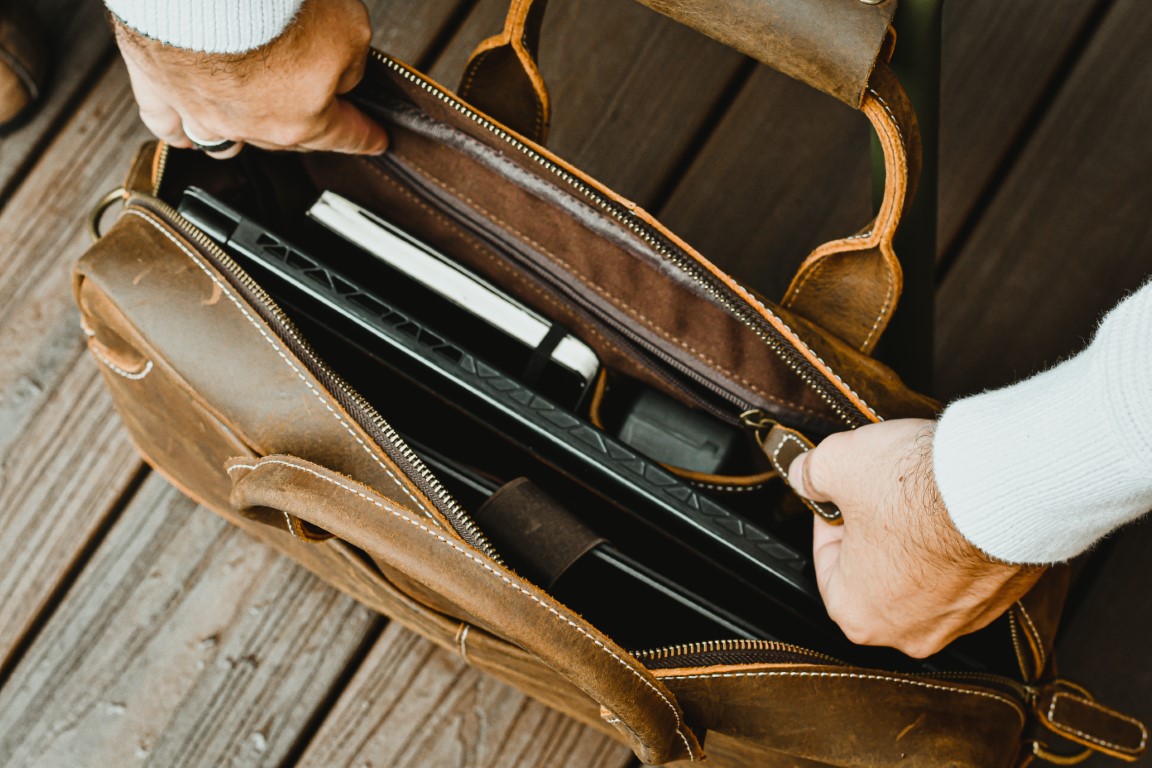
Maximizing Resources: How Leather Production Utilizes By-Products
By utilizing by-products, leather production maximizes resources and promotes resource efficiency. Leather production is known for its sustainable methods, and one of the ways it achieves this is by making use of all parts of the animal. When animals are raised for meat consumption, their hides would otherwise go to waste if not used for leather production. Instead, the byproduct leather industry utilizes these hides and transforms them into a valuable material. This not only reduces waste but also maximizes the resources available. Additionally, other by-products such as fats, oils, and proteins can be extracted from the animal's carcass and used in various industries. By maximizing the use of these by-products, leather production contributes to a more efficient and sustainable use of resources.
Reducing Waste Streams: A Holistic Approach to Resource Efficiency
To achieve a holistic approach to resource efficiency, leather production focuses on reducing waste streams through the utilization of by-products and a sustainable use of resources. This approach is crucial in addressing environmental concerns and ensuring a more sustainable future. By utilizing by-products, such as hides and skins, leather production minimizes waste and maximizes resource efficiency. Additionally, the leather industry is exploring alternatives to leather that are more sustainable, such as recycled leather and plant-based materials. These sustainable alternatives not only reduce waste but also alleviate concerns regarding animal welfare and the environmental impact of traditional leather production. By adopting a comprehensive approach to resource efficiency, the leather industry strives to minimize waste streams and contribute to a more sustainable and eco-friendly future.
Sustainable Ranching Practices
When it comes to sustainable ranching practices, it is crucial to consider the ethical origins of leather. Responsibly sourced leather ensures that animals are raised in humane conditions and their welfare is prioritized. Additionally, sustainable ranching practices contribute to preserving biodiversity and maintaining healthy ecosystems, as leather production can be integrated with regenerative agriculture methods that promote soil health and minimize environmental impacts.
Ethical Origins: The Importance of Responsibly Sourced Leather
Responsible sourcing of leather through sustainable ranching practices is crucial for ensuring the ethical origins of this material. By implementing ethical practices and fair labor practices, the leather industry can contribute to a more sustainable and responsible production process. Responsible sourcing involves ensuring that the animals used for leather production are raised in an ethical manner, with proper care, adequate living conditions, and access to natural resources. This includes promoting sustainable ranching practices that prioritize animal welfare and environmental stewardship. By supporting sustainable leather products, consumers can contribute to the growth of an ethical leather industry that values transparency and responsible sourcing. It is important to educate ourselves about the origins of leather goods and choose products from companies that prioritize ethical practices and sustainable sourcing methods.
Preserving Biodiversity: Leather Production and Sustainable Ecosystems
Sustainable ranching practices in leather production play a vital role in preserving biodiversity and ensuring the long-term health of ecosystems. Leather is often made from animal hides, which are a byproduct of the meat industry. By utilizing these hides, leather production reduces waste and maximizes the use of animal products. However, it is important to note that not all leather production is sustainable. The use of chromium tanning, for example, can have negative environmental impacts. To address this issue, sustainable leather manufacturers are adopting alternative tanning methods that minimize harm to the environment. Additionally, sustainable ranching practices prioritize the health and well-being of the animals, ensuring that their habitats are protected and biodiversity is preserved. By choosing leather from sustainable sources, you can support the preservation of ecosystems while enjoying a durable and stylish product.
Carbon Footprint: Leather's Surprisingly Low Impact
Assessing the environmental impact of materials is crucial for making sustainable choices. Leather often has a lower carbon footprint compared to synthetic alternatives, and sustainable grazing practices further enhance its environmental profile.
| Area of Assessment | Leather's Advantage | Key Details & Environmental Impact |
|---|---|---|
| Calculating Carbon: Comparing Footprints | Leather has a surprisingly low carbon footprint compared to alternative and synthetic materials. |
|
| Sustainable Grazing: Carbon Solutions | Livestock can play a crucial role in carbon solutions when managed through sustainable grazing practices. |
|
Calculating Carbon: Comparing Leather's Footprint to Alternative Materials
Leather's carbon footprint is surprisingly low compared to alternative materials, making it a more environmentally friendly choice. When comparing the carbon emissions of leather production to other materials such as synthetic leather or plastics, leather comes out on top. Synthetic leather production involves the use of fossil fuels, which contribute significantly to carbon emissions and environmental pollution. On the other hand, leather is a natural and renewable material that has a lower impact on the environment. Additionally, bio-based leather alternatives, which are made from sustainable and biodegradable materials, further reduce the carbon footprint associated with leather production. Furthermore, compared to the water footprint of other materials, leather production has a relatively lower impact. By choosing leather, you can contribute to reducing environmental risks and supporting a more sustainable future.
Sustainable Grazing: Understanding How Livestock Can Be Part of Carbon Solutions
Livestock can play a crucial role in carbon solutions through sustainable grazing practices. Cattle ranching, when managed sustainably, can have positive environmental benefits. Grazing animals help to maintain grasslands, which act as carbon sinks, absorbing and storing carbon dioxide from the atmosphere. As cattle graze on grass, they stimulate its growth and root development, enhancing the grassland's ability to sequester carbon. Additionally, well-managed grazing systems promote biodiversity, as they allow for the coexistence of livestock and native wildlife. By supporting sustainable grazing practices, the animal leather industry demonstrates its commitment to sustainability and environmental stewardship. These practices contribute to the overall carbon solutions and help mitigate the impacts of climate change. Embracing sustainable grazing is an important step towards achieving a more environmentally friendly and responsible approach to cattle ranching.
Recyclability and Upcycling Initiatives

Now let's explore the recyclability and upcycling initiatives of leather. Leather has the potential to go beyond a single life, as it can be recycled into new products. Through creative reuse, old leather can be transformed into stylish, innovative items, reducing waste and extending the lifespan of the material. These initiatives highlight the sustainable possibilities of leather and its contribution to a circular economy.
Beyond a Single Life: Exploring Leather's Potential for Recycling
Exploring the potential for recycling and upcycling initiatives, leather offers a sustainable solution for extending its lifespan beyond a single use. Recycling leather helps reduce waste and minimize the environmental impact of leather production. Leather can be recycled by breaking it down into its fibers and reconstituting them to create new leather products. This process not only reduces the demand for new raw materials but also saves energy and reduces greenhouse gas emissions associated with leather production. Additionally, leather can be upcycled, transforming old or discarded leather products into new, high-quality items. By giving leather products a second life through recycling and upcycling, we can contribute to a more sustainable and environmentally-friendly future. Leather's potential for recycling and upcycling initiatives holds great promise in achieving long-term sustainability goals.
Creative Reuse: Turning Old Leather into New, Stylish Products
By repurposing old leather products, you can contribute to a more sustainable future while adding a stylish touch to your wardrobe. Creative reuse initiatives are gaining popularity as a way to reduce waste and extend the life cycle of leather. Old leather items, such as jackets, bags, and belts, can be transformed into new, stylish products through upcycling techniques. These techniques involve redesigning and reimagining the leather, giving it a new purpose and aesthetic appeal. Upcycled leather products not only help reduce the demand for new leather but also minimize the environmental impact associated with leather production and disposal. By participating in creative reuse initiatives, you can play a role in reducing landfill waste and promoting a more sustainable fashion industry. So, why not give old leather a new lease on life and embrace the benefits of creative reuse?
The Top 5 Best Leather Messenger Bags
Looking for the best leather messenger bags? Look no further. The Bjorn Leather Laptop Bag, Baldwin Black Leather Business Bag, The Faust Leather Camera Bag, The Dagmar Leather Briefcase, and The Welch Briefcase are all top contenders. These bags not only offer style and durability but also provide a practical and functional solution for carrying your essentials in a sleek and sophisticated manner.
The Bjorn Leather Laptop Bag
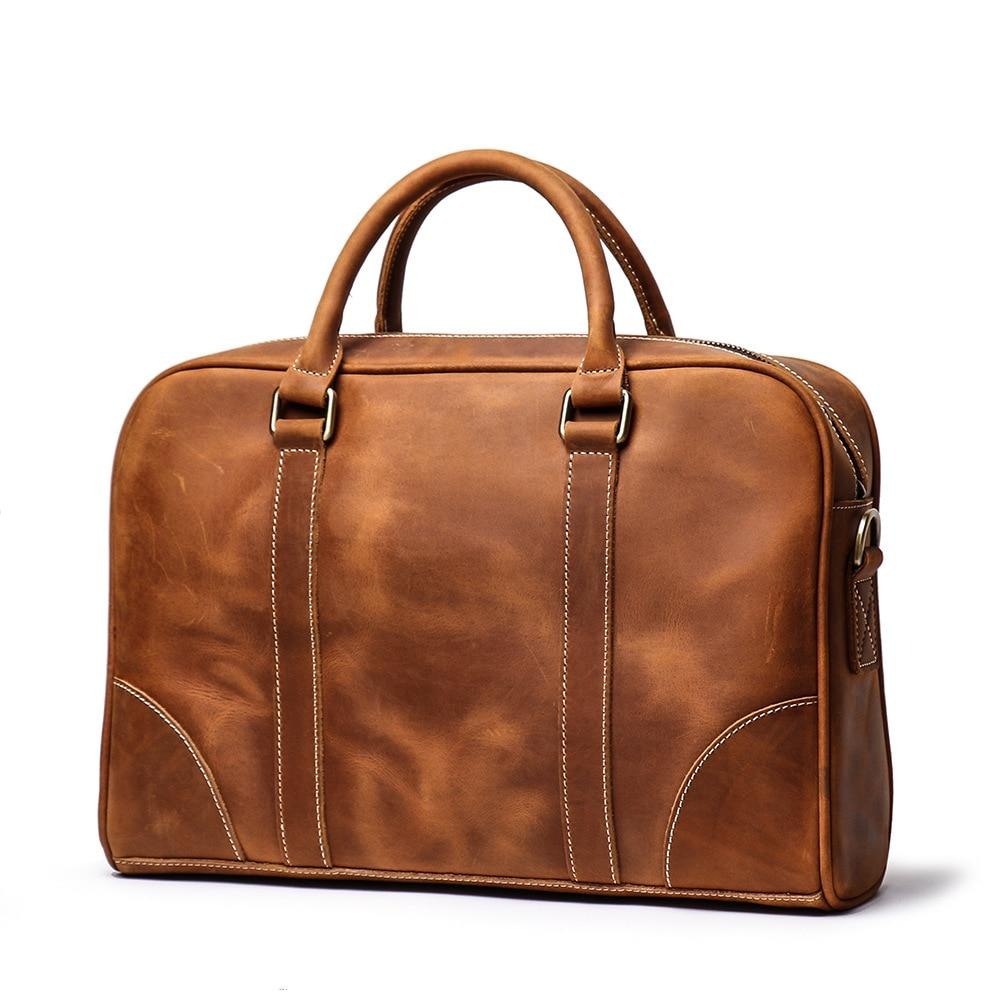
The Bjorn Leather Laptop Bag stands out as one of the top five best leather messenger bags, offering a stylish and eco-friendly choice for those seeking the environmental benefits of leather. Made from high-quality leather, this laptop bag not only provides a durable and long-lasting option but also contributes to sustainability. Leather is a natural material that is biodegradable and reduces waste in landfills. Additionally, the production of leather involves fewer chemicals and energy compared to synthetic materials, making it a more environmentally friendly choice. The Bjorn Leather Laptop Bag is designed with functionality in mind, featuring multiple compartments and a padded interior to protect your laptop. With its sleek design and eco-conscious construction, this bag offers a perfect blend of style and sustainability for the freedom-minded individual.
Best For: The Bjorn Leather Laptop Bag is best for professionals and individuals who value both style and sustainability in their choice of a laptop bag.
Pros:
-
Made from high-quality leather for durability and longevity.
-
Multiple compartments and padded interior provide excellent functionality and protection for laptops.
-
Eco-friendly choice as leather is biodegradable and reduces waste in landfills.
Cons:
-
The price may be higher compared to synthetic material laptop bags.
Baldwin Black Leather Business Bag
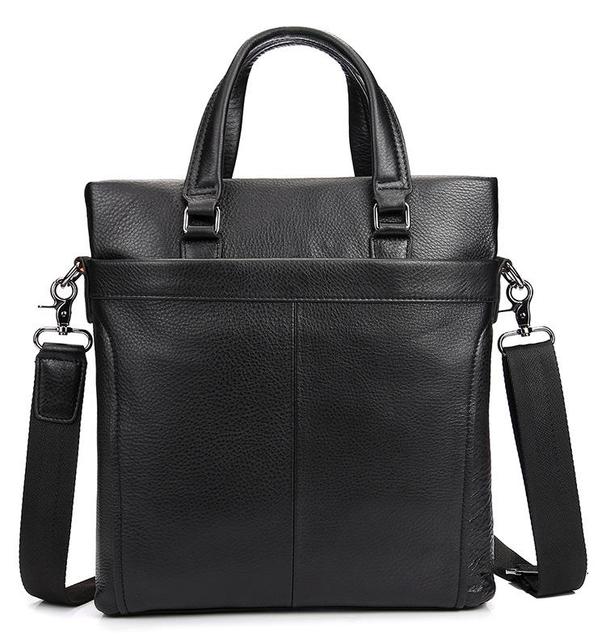
For those seeking a durable and stylish messenger bag, the Baldwin Black Leather Business Bag stands out as a top choice, offering both functionality and a timeless aesthetic. Made of high-quality black pebbled top grain leather, this bag is handcrafted by artisans with over 30 years of experience. With dimensions of 13 x 11.8 x 2.75 inches and a weight of 2 lbs, it is the perfect size for your everyday essentials. The Baldwin Black Leather Business Bag is made of crazy horse leather, which is known for its unique retro, vintage look. This type of leather is highly resistant to water and other liquids, making it a durable and practical choice. Additionally, the bag develops a beautiful patina over time, adding to its antique and vintage appearance. Embrace both style and functionality with the Baldwin Black Leather Business Bag.
Best For: Professionals and business professionals who prioritize durability and style in their messenger bag.
Pros:
-
Made of high-quality black pebbled top grain leather
-
Handcrafted by artisans with over 30 years of experience
-
Highly resistant to water and other liquids
Cons:
-
May be on the pricier side compared to other messenger bags
The Faust Leather Camera Bag

The Faust Leather Camera Bag offers photographers and camera enthusiasts a stylish and durable solution for protecting their equipment while enjoying the environmental benefits of leather. Made with full grain leather and handcrafted using traditional techniques, this bag is designed to withstand the test of time. Its thick and durable material, along with meticulous stitching and vintage design, ensures that your camera and accessories are well-protected. The bag features adjustable straps for a comfortable fit and provides multiple compartments and pockets for organized storage. With its dimensions of 10.4 x 6.2 x 4 inches and weight of 1.8 lbs, it is the perfect size for carrying your camera body with lens attached, as well as additional lenses and accessories. The bag is made of high-quality crazy horse leather, which is highly resistant to water and other liquids, adding to its durability. Each bag is unique due to the wax and manufacturing process, giving it a retro, vintage appearance. Ordering is easy through the website, and various payment options are accepted. Returns are also accepted within 30 days, with certain conditions. Shipping times vary depending on location. The Faust Leather Camera Bag is a practical and stylish choice for photographers who value both functionality and sustainability.
Best For: Photographers and camera enthusiasts looking for a stylish and durable camera bag to protect their equipment.
Pros:
-
Made with full grain leather and handcrafted using traditional techniques for long-lasting durability.
-
Features adjustable straps and multiple compartments for comfortable and organized storage.
-
Made of high-quality crazy horse leather, which is highly resistant to water and adds a unique vintage appearance.
Cons:
-
Shipping times can vary from 3-30 business days depending on location.
The Dagmar Leather Briefcase
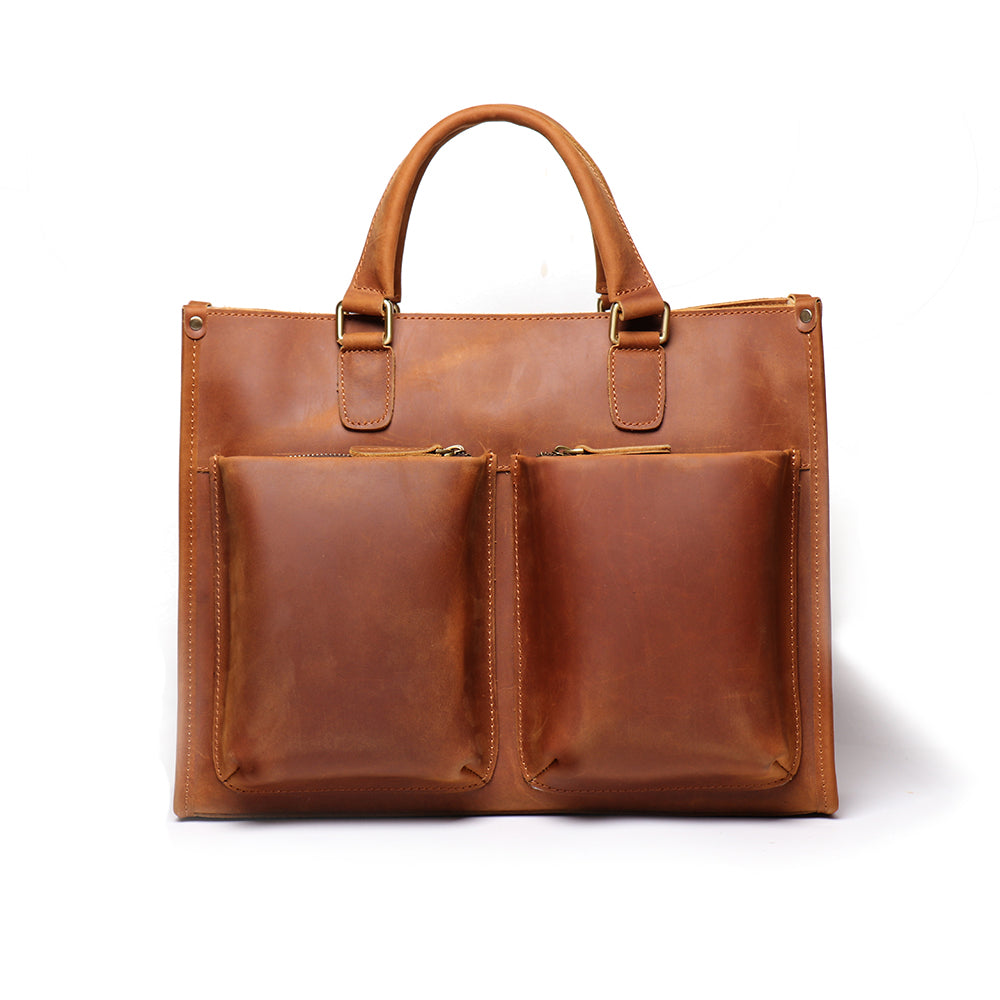
When looking for a leather messenger bag that combines style and durability, the Dagmar Leather Briefcase stands out as the top choice for those who prioritize environmental benefits. Made of high-quality crazy horse leather, this briefcase offers a unique retro, vintage look that ages beautifully over time. The wax applied to the leather surface makes it highly resistant to water and other liquids, ensuring its durability and ability to withstand wear and tear. Each bag made of crazy horse leather is also unique due to the manufacturing process. With dimensions of 15 x 12 x 3.6 inches and weighing 3.3 lbs, the Dagmar Leather Briefcase offers ample space with its multiple compartments, including a large zippered compartment, phone compartments, and a laptop sleeve. If you value both style and sustainability, the Dagmar Leather Briefcase is an excellent choice.
Best For: Individuals seeking a stylish and durable leather briefcase with a retro, vintage look.
Pros:
-
Made of high-quality crazy horse leather for durability and resistance to water and other liquids.
-
Multiple compartments, including a large zippered compartment, phone compartments, and a laptop sleeve.
-
Unique and aging beautifully over time due to the manufacturing process.
Cons:
-
The weight of 3.3 lbs may be heavy for some individuals.
The Welch Briefcase
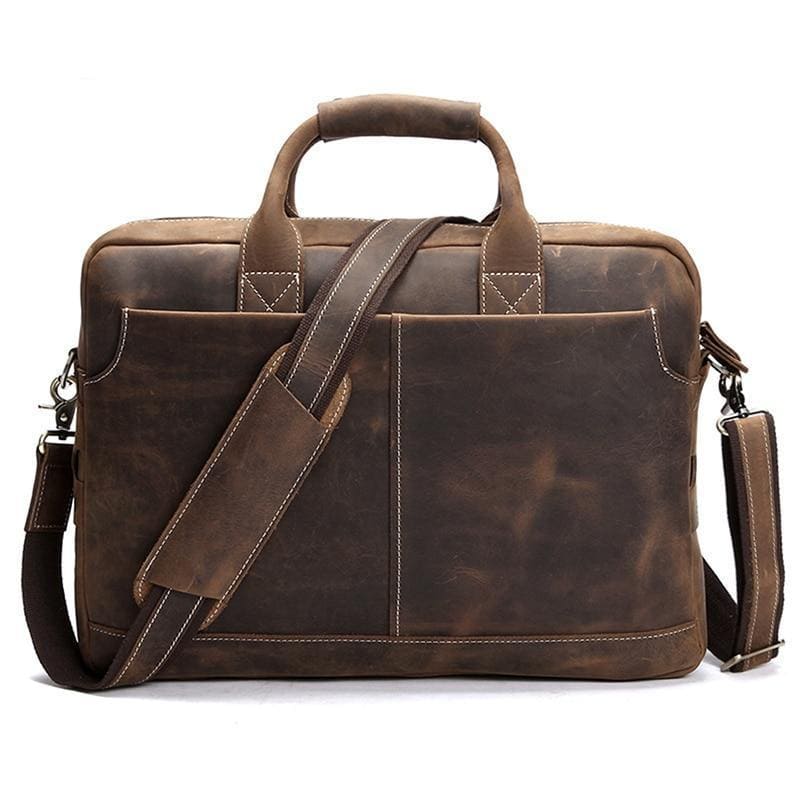
Looking for a leather messenger bag that combines comfort and style while offering ample storage space? The Welch Briefcase is the perfect choice for individuals seeking the environmental benefits of leather. Made of high-quality crazy horse leather, this bag is not only durable and strong but also ages beautifully over time. It features a combination of shoulder bag and briefcase design, providing both comfort and functionality. With dimensions of 16.5 x 12 x 3.5 inches and a weight of 3.7 lbs, it can securely carry laptops up to 15 inches. The interior features multiple compartments and pencil holders, allowing for organized storage. The bag also has a leather-lined comfortable grab handle and ergonomically-designed adjustable straps for even weight distribution. Currently priced at $199.00 during a limited-time sale, the Welch Briefcase offers an attractive price for a high-quality leather bag.
Best For: Individuals who value both style and functionality in a leather messenger bag.
Pros:
-
Combination of shoulder bag and briefcase design offers versatility
-
Ample storage capacity with multiple compartments and pencil holders
-
Made of high-quality crazy horse leather, durable and ages beautifully over time
Cons:
-
Limited stock may create urgency for potential buyers
Frequently Asked Questions
What Are the Ethical Concerns Associated With Leather Production?
When considering the ethical concerns of leather production, it is important to acknowledge the potential environmental impact and climate change implications. The tanning process involves chemical-intensive processes that use heavy metals and chromium salts, which can cause water pollution and harm ecosystems. Chrome tanning, while efficient, presents particular concerns due to chromium tanning methods that may affect water recycling systems. Additionally, the farming of animals for leather requires land, water, and food resources, which can contribute to deforestation, water scarcity, and food insecurity. The meat industry and animal farming practices raise questions about factory farming and animal welfare certification standards. These concerns highlight the need for sustainable materials and bio-based leather alternatives that minimize environmental harm and prioritize animal welfare while supporting a circular economy approach.
How Does Leather Compare to Synthetic Materials in Terms of Environmental Impact?
Genuine leather has a lower environmental impact compared to synthetic leather in many cases. It is a natural material made from animal hides that is biodegradable and represents one of the more durable materials available when properly cared for. Chrome-tanned leather production requires consideration of manufacturing impact, though vegetable tanning offers more environmentally-friendly practices. A comprehensive life cycle assessment shows that animal-based leather can be recycled and repurposed as an upcycled product, reducing waste in support of cradle to cradle principles. However, synthetic tanning methods and aldehyde tanning processes in synthetic materials often involve VOC emissions and energy-intensive production. The leather industry is increasingly adopting energy-saving measures, hydroelectric power, and following GHG protocol standards. It's important to consider the ethical concerns associated with tanning leather, such as companion animals versus farmed animals and the chemical processes involved in creating the protective layer that makes leather durable.
Are There Any Alternatives to Leather That Are More Sustainable?
Are there any alternatives to leather that are more sustainable? Yes, there are several sustainable choice options beyond traditional animal skins processing. These include innovative materials such as cork, pineapple leather made from agricultural waste, mushroom leather developed through cellular agriculture, and apple leather utilizing fruit industry byproducts. Plant-based vegan leather and other plant-based fabrics represent a growing category of leather-like material that often uses collagen protein polymer or engineered living materials developed through synthetic biology principles. These alternatives typically require fewer resources and have a lower environmental impact compared to traditional chromium-tanned leather. Additionally, they align with animal advocacy principles and offer a more ethical sustainable choice for those looking to embrace environmental stewardship in their fashion decisions. Many of these bio-based leather alternatives also come with eco-friendly packaging and support regenerative agriculture practices.
What Are the Social Implications of the Leather Industry?
The social implications of the leather working group standards and broader leather industry can be far-reaching. From the exploitation of workers in low-wage countries to the harmful effects on local communities and indigenous populations, the industry faces significant ethical concerns. The social movement toward more sustainable practices has highlighted issues where leather production involves child labor and unsafe working conditions in some regions. The sustainable leather foundation and similar organizations work to address these challenges through program evaluation and promoting sustainable leather alternatives. These issues underscore the importance of supporting regenerative agriculture, responsible animal farming practices, and the development of renewable leather options that prioritize both environmental stewardship and worker welfare.
How Can Consumers Ensure That the Leather They Purchase Is Sustainably Sourced?
To ensure you're purchasing sustainably sourced leather, there are several steps you can take. First, look for certifications like the Leather Working Group's gold rating, which guarantees environmentally-friendly practices throughout tanning techniques and production. Second, research the brand's transparency and commitment to sustainable practices, including their approach to recycling materials and energy transition initiatives. Third, consider alternative materials like plant-based leather, recycled leather, or full-grain leather that has been processed using vegetable tanning methods rather than traditional chrome tanning approaches. Look for products that demonstrate medical applications testing for safety and incorporate collagen protein responsibly. Finally, support brands that prioritize animal welfare and ethical sourcing while investing in an apron for life philosophy of durability over disposability. By being informed and conscious consumers focused on environmental stewardship, we can contribute to a more sustainable and ethical industry that embraces circular economy principles and supports the development of innovative materials through cellular agriculture and sustainable manufacturing processes.
Conclusion
Leather isn't just a fashion statement, it's an environmental superhero! Its biodegradability means it effortlessly returns to the earth, while its longevity means less waste. With eco-friendly tanning processes and sustainable ranching practices, leather has a surprisingly low carbon footprint. Plus, it can be recycled and upcycled, adding to its sustainability. So, if you want to make a stylish statement and save the planet at the same time, embrace leather!






















